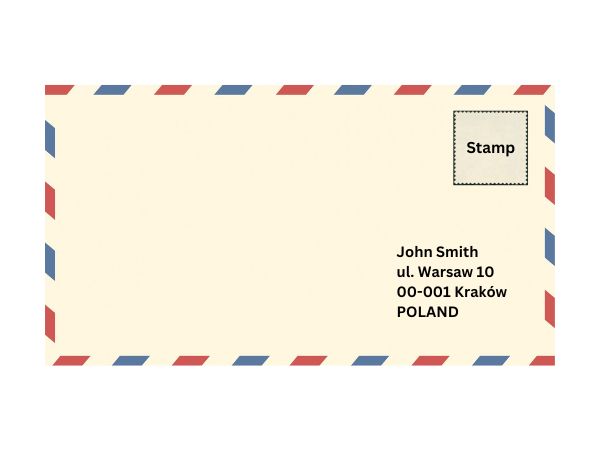In today’s digital age of instant messaging and chats, there’s something undeniably special about sending a real letter through the mail.
But the process of sending a letter to another country, like Poland, can be overwhelming. If you don’t write the details on the envelope correctly or forget to include the proper address format, it can result in the delay or misrouting of the letter.
Therefore, in this article, we will guide you all about the proper address format, its alignment on the envelope, Polish postal codes, and the other ins and outs of sending a letter to Poland.
If you’re looking for the quickest and easiest way to send a real letter to Poland, let us do the heavy lifting. With e-Snail, you can send a physical letter to anywhere in the world.
Poland Address Format
Writing the proper address is vital for the accurate delivery of letters to Poland, minimising the risk of any hindrances or delays.
Here are some important guidelines to follow, along with details about address components, format, and alignment.
General Guidelines for Formatting a Polish Address
- Maintain consistent spacing between address components to enhance readability. Also, avoid squeezing or overcrowding the address elements, which can lead to confusion or misinterpretation.
- Make sure to stick to alphanumeric characters when writing the address. Try not to use symbols, emojis, or other special characters that may cause confusion during the mail sorting process.
- While periods and commas are generally acceptable in an address, avoid using unnecessary punctuation marks that can clutter the address and potentially cause errors. You can use a comma to separate lines and periods for abbreviations.
Polish Address Components
- Recipient’s name: Include the full name of the person or organisation intended to receive the letter.
- Street name: Write the name of the street or avenue where the recipient is located.
- House number: Indicate the specific number associated with the recipient’s address right after the street name.
- Postal code: Include the five-digit Polish postal code, formatted properly as described below. It is to be written before the city/locality name in the same line.
- City/locality name: Provide the name of the city or locality where the recipient lives.
- Country name: Write the name of the country in capital letters in a separate line under the city.
Polish Address Example
The below is an example of a typical Polish address. More information on abbreviations can be found later on in this post:
John Smith
ul. Warsaw 10
00-001 Kraków
POLAND
Polish Address Alignment
As well as address format, you must also know where to put it on the envelope. Clear and aligned address elements enable postal workers to quickly identify and route the mail accurately.
The alignment typically includes writing the sender’s details on the upper-left corner and the recipient’s information on the bottom-right corner of the envelope. Basically, you start with the full name of both the sender and the recipient. Then, follow with their house address and street name, postal code, city, and country on the respective corners.
Additionally, an important point to remember for alignment is to leave roughly 1.5cm of space blank from the bottom end of the envelope, from both the front and back sides. This is where barcodes will be printed on your parcel.
Polish Postal Codes
When you are sending a letter to Poland, you have to write the postal code of that specific area before the city or locality name in the same line. You must write the postal code in its distinct format to ensure the mail is not held back or delivered to the wrong locality.
So, the code is made up of 5 digits in the format xx-yyy. Here “X” and “Y” both represent digits that refer to different components of the location. For example:
00-001 Kraków
The first digit indicates one of the ten postal districts in the country. While the subsequent digit specifies the district’s major geographical subdivision.
Finally, the last three digits after the dash provide more specific details, such as the number of a postal delivery branch. In the case of large cities, it may refer to a specific street or a part of the street.
Polish Address Abbreviations and Titles
When sending a letter to Poland, it’s helpful to be familiar with important titles and abbreviations used in address formatting. Here are some key ones to keep in mind:
- Mr. (Pan): For addressing a man in a formal or professional context.
- Mrs. (Pani): A title for a married or older woman in a formal or professional context.
- Miss (Panna): This is for addressing an unmarried woman in a formal or professional context.
- Dr. (Doktor): Used as a title for individuals with a doctorate degree, such as medical doctors or PhD holders.
- ul. (ulica): Abbreviation for “street” in Polish. It is used before the name of the street in the address.
- al. (aleja): Short for “avenue”. You can add this before the name of the avenue in the address.
- m. (mieszkanie): Abbreviation for “apartment”. It is used to indicate the apartment number in the address.
There are no specific abbreviations used for cities as they are to be written with their full name.
Language and Cultural Considerations in Polish Letter Writing
When sending a letter to Poland, it is important to be aware of local nuances to ensure effective communication and smooth delivery. Polish communication often involves a level of formality, so using proper titles, as mentioned above, and maintaining a respectful tone is appreciated.
Also, make sure to familiarize yourself with the specific guidelines of the Polish postal service to understand their mailing options. There can be delays due to local holidays or other factors. It is advisable to send important mail in advance to account for any possible delays.
Restricted Items and Prohibited Content to Mail to Poland
Poland has specific regulations regarding the mailing of certain items, including illegal drugs, weapons, explosives, hazardous materials, and counterfeit goods. These items are strictly prohibited and should never be sent through the mail.
Moreover, there are other items that are subject to restrictions and may require special permits or documentation to be mailed to Poland. These include gold, traveller’s checks, jewellery, currency notes, and certain medications.
In addition to physical items, it’s essential to be mindful of the content within the mail. Materials that are obscene, offensive, or in violation of intellectual property rights, such as unauthorized copies of copyrighted works, should not be included in the mail.
Furthermore, it is strongly recommended to check with the Polish postal authorities or consult the official regulations to determine the specific requirements and restrictions for mailing any unusual items.
Conclusion
When sending a letter to Poland, you must consider all the crucial factors for a successful delivery. And the main element here is to use the proper address format on the envelope. Also, pay special attention to writing the postal code correctly.
Moreover, utilise common abbreviations and titles to bring more clarity, while keeping to the cultural nuances and prohibited items.
Don’t forget, you can also use e-Snail to easily send a letter online to anywhere in the world, including Poland.




